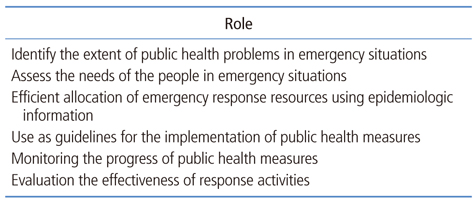 |
 |
- Search
| J Korean Med Assoc > Volume 60(4); 2017 > Article |
Abstract
Public health emergencies caused by infectious diseases are the greatest threat to mankind in the 21st century, and pose an even more significant threat than nuclear weapons. The first step in preparing for and responding to such public health emergencies is to conduct thorough surveillance and rapid epidemiological investigations. Especially in the case of public health emergencies, most information is not smoothly transmitted. Therefore, it is necessary to evaluate the emergency and to collect data quickly and efficiently by defining the minimum necessary data and information. In addition, these data should be analyzed and interpreted promptly, and countermeasures and strategies should be developed and utilized in preparedness and response activities. Epidemiological investigations should also be carried out promptly in accordance with the emergency situation, and in particular, if the infection source is not known, maximal measures should be taken to prevent epidemiologists from becoming infected. In order to carry out surveillance and epidemiological investigations effectively in the future in the event of a public health emergency, continuous efforts should be made to nurture professional manpower, international cooperation, and use of the latest information technology.
References
1. O'Brien EC, Taft R, Geary K, Ciotti M, Suk JE. Best practices in ranking communicable disease threats: a literature review, 2015. Euro Surveill 2016;04. 28. 10.2807/1560-7917.ES.2016.21.17.30212. [Epub].
2. In: Gregg MB, editor. Field epidemiology. 3rd ed. Oxford: Oxford University Press; 2008.
3. Lee LM, Teutsch SM, Thacker SB, St. Louis ME. Principles and practice of public health surveillance. 3rd ed. Oxford: Oxford University Press; 2010.
4. World Health Organization. Emergencies preparedness, response: integrated disease surveillance [Internet] Geneva: World Health Organization. 2004;cited 2017 Apr 2. Available from: http://www.who.int/csr/labepidemiology/projects/diseasesurv/en/
5. World Health Organization. Public health surveillance [Internet] Geneva: World Health Organization. cited 2017 Apr 1. Available from: http://www.who.int/topics/public_health_surveillance/en/
6. Lee C, Ki M. Strengthening epidemiologic investigation of infectious diseases in Korea: lessons from the Middle East respiratory syndrome outbreak. Epidemiol Health 2015;37:e2015040.



7. McSpadden K. Bill Gates thinks this is the deadliest threat to humankind. Time 2015;05. 28. cited 2017 Apr 4. Available from: http://time.com/3899414/bill-gates-disease-epidemic-ebola-threat-to-humanity-disaster/#3899414/bill-gates-disease-epidemic-ebola-threat-to-humanity-disaster/.8
- TOOLS
-
METRICS

-
Related articles in
J Korean Med Assoc -
Functions and roles of public healthcare for controlling infectious diseases2015 July;58(7)
Public health emergency preparedness and response to emerging infectious diseases2017 April;60(4)







